Workflows
The Workflow Repository view provides an overview of End-to-End Workflows and quick access to related tasks. Users may deploy, redeploy, remove, and unlock Workflows here, and furthermore modify the configuration table of a specific Workflow revision. All these options are callable either via the toolbar or the context menu, opened by right-clicking Workflows (table row). Several toolbar buttons/context menu items are disabled by default, but enabled if at least one Workflow is selected.
Workflows are managed by a version control system, the Workflow Repository, which stores all Workflow modifications in separate revisions. Therefore, users are able to deploy different revisions of the same Workflow to different Robots.
Due to Control Center's multitenancy, Workflows are assigned to specific Customers. Within the Workflow Repository view, logged-in standard users only see Workflows associated with their own Customers. System Users see the Workflows associated with the Customers currently selected by the Customer Switch. This rule has one exception: when the Customer Switch is set to [System], System Users see all End-to-End Workflows for all Customers.
Please note: The following description differentiates between System Users and standard users because there are differences in the menus and options available.
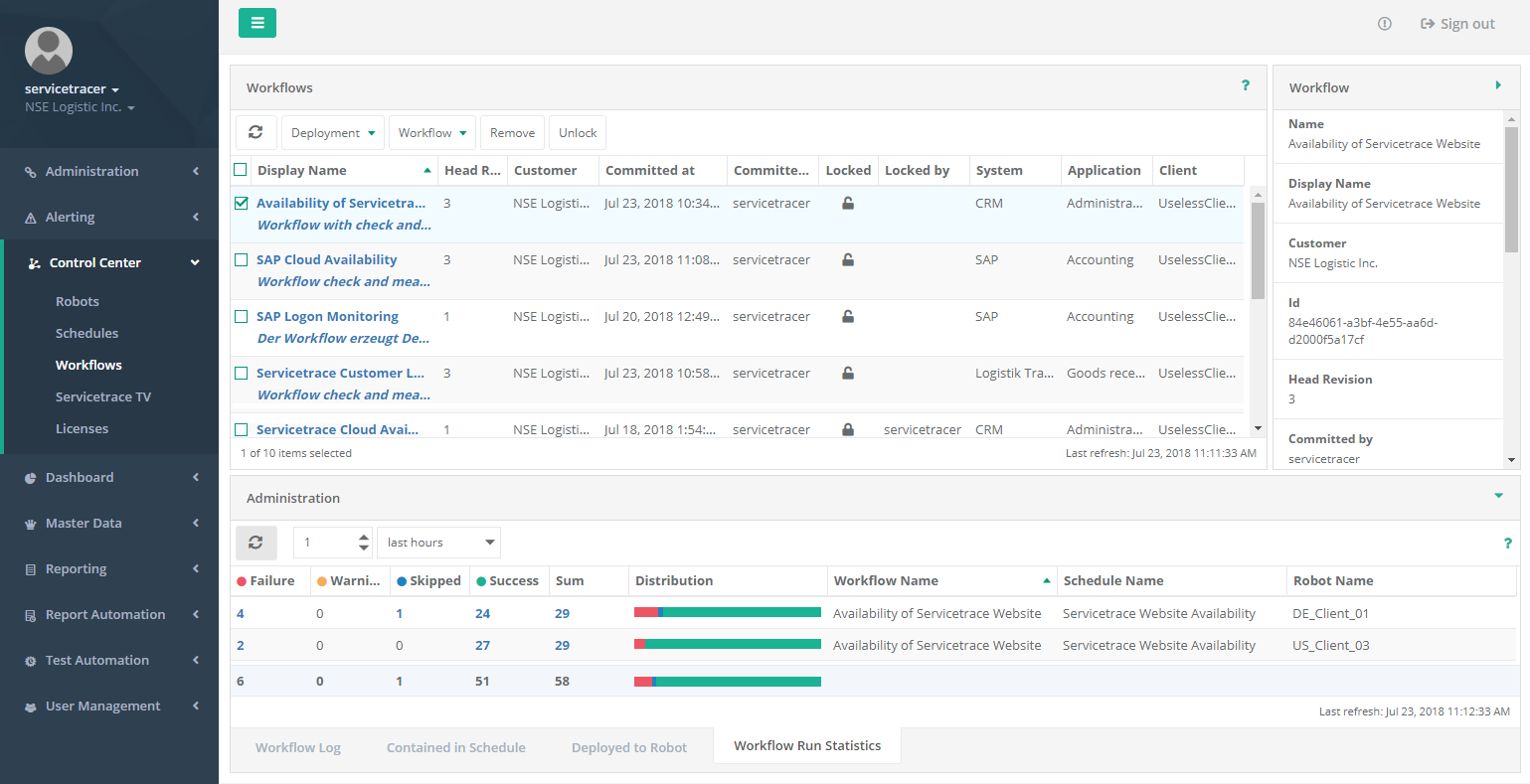
The left pane of the Workflow Repository view shows the Control Center sub menus, with the current view highlighted.
The main part of the window contains a table listing all Workflows associated with the logged-in user's Customer, along with a subset of their properties. This list of Workflows supports multiple selections. If only a single Workflow is selected, its detailed view containing all properties is shown in the right pane.
 can only be used with the web application of the same name. They can not be deployed via Control Center.
can only be used with the web application of the same name. They can not be deployed via Control Center.
All Workflows already contained in the System before version 4.3 are initially of type End-to-End
 . You can only change the type of a Workflow by using the Option Save
As in WorkflowEditor 4.1 or higher.
. You can only change the type of a Workflow by using the Option Save
As in WorkflowEditor 4.1 or higher.
The bottom Workflow Repository pane shows several tabs containing Workflow related information. These tabs can only be refreshed if at least one Workflow is selected.
Multitenancy
Due to Control Center's multitenancy, Customers only see their own Workflows. Logged-in standard users only see their assigned Customers. System Users see the Customer currently selected by the Customer Switch. When the Customer Switch is set to [System], System Users see all Workflows for all Customers.
To guarantee multitenancy, standard Schedules only contain Workflows associated with the same Customer. System Schedules may contain Workflows associated with any Customer.
This special functionality for System Schedules was implemented to support service providers, who typically use several System Users to manage the Control Center. Providers may offer a service where they Schedule Workflows created and managed by their Customers. To facilitate this, providers may Schedule Customer Workflows within System Schedules. Due to multitenancy, these System Schedules will not be visible to their Customers (who are standard users with respect to Central Server®). Thus the scheduling of Customer Workflows is under the provider's control.
Menu
The Schedule Management view toolbar and context menu differ depending on the type of logged-in user. standard logged-in users require privileges to access several menu items. If standard logged-in users do not have the privileges required, the corresponding menu items will not be shown in the toolbar or context menu. If a System User is logged in, then the context menus vary depending on the Customer currently selected by the Customer Switch. The differences are explained by the respective menu item.
Workflow Log
The Workflow Log tab shows all revisions of the Workflow selected.

In addition to revision, log message, and Master Data, the revision history gives information about the creation and modification of the respective Workflow revision as well.
- Committed at: Date/time the Workflow revision was created by means of Workflow Studio
- Committed by: Name of user who created the Workflow revision by means of Workflow Studio.
- Config changed at: Date/time the Workflow revision was modified, i.e. the Workflow revision configuration table was modified.
- Config changed by: Name of user who modified the Workflow revision, i.e. who modified the Workflow revision configuration table.
The Min. Robot Version column shows the earliest robot version that can be used to execute this Workflow.
The following default values will be assigned automatically when a Workflow is uploaded to the repository or when an existing Workflow is
migrated.
The following list still contains the term Agent in cases where the software of a specific version was also called Agent. The first Robot version is 4.5.0.
- WorkflowEditor 2.2: Min. Robot Version Agent 3.0
- WorkflowEditor 2.3: Min. Robot Version Agent 4.0
- WorkflowEditor 3.0: Min. Robot Version Agent 4.0
- WorkflowEditor 4.0: Min. Robot Version Agent 4.0
- WorkflowEditor 4.1: Min. Robot Version Agent 4.3
- WorkflowEditor 4.2: Min. Robot Version Agent 4.3
- WorkflowEditor 4.3: Min. Robot Version Agent 4.3
Menu
The revision history supports the following menus:
Contained in Schedule
The Contained in Schedule tab shows all schedules containing the selected Workflow.

Menu
The tab supports the following menu.
Deployed to Robot
The Deployed to Robot tab shows all Robots that the selected Workflow is deployed to.

Menu
This tab supports the following menus:
Workflow Run Statistics
The Workflow Run Statistics tab shows statistics of Workflow executions if at least one Workflow is selected. Within the selected time interval, users are able to analyze the execution results by Workflow with respect to the four outcomes Failure, Warning, Skipped, and Success. In addition to the raw statistical values, a distribution graph helps to visualize the results: failures are colored red, warnings yellow, skipped executions blue, and successful executions green. This tab supports the retrieval of four different lists of Workflow run statistics.
- The Workflow run statistics from the last N hours.
Please note: A maximum time span of 72 h may be specified. For performance reasons, statistics are calculated based on a maximum of 100,000 results per Workflow. This may lead to run statistics starting later than the specified N hours in the past.
- The Workflow run statistics of the N last hours leading up to the specified date and time. The time has to be
provided in 24 hour format (hh:mm:ss).
Please note: A maximum time span of 72 h may be specified. For performance reasons, statistics are calculated based on a maximum of 100,000 results per Workflow. This may lead to run statistics that finish at the specified date and time, but start later than the specified N hours in the past.
- The last N Workflow run statistics.
Please note: A maximum value N of 100,000 can be specified. The value N applies to each selected Workflow, i.e. statistics are calculated based on N results per Workflow.
- The last N Workflow run statistics leading up to the specified date and time. Time has to be specified in 24 hour
format (hh:mm:ss).
Please note: A maximum value N of 100,000 can be specified. The count N applies to each selected Workflow, i.e. statistics are calculated based on N results per Workflow.

The bottom row shows the sum of values in the respective column. In addition to the distribution graph, users may view the percentage distribution of Workflow run statistics as a pie chart by hovering over the corresponding cell in the Distribution column.
To facilitate analysis of Workflow executions, the tab supports different kinds of drill-downs. Drill-downs are shown in an overlay window, displaying detailed Workflow run results filtered with respect to the selected drill-down.
To reflect the statistics selected, the drill-down changes the time interval as follows:
| Workflow Run Statistics Time Interval | Drill-Down Time Interval |
| Last hours | Most recent N results prior to the last update of the Workflow run statistics. N is the number of results to display for the selected outcome types. |
| Last N results | |
| Last hours until | Most recent N results prior to the date/time specified in the Workflow run statistics. N is the number of results to display for the selected outcome types. |
| Last N results until |
For example, the following screenshot shows the last N run results as a result status drill-down.
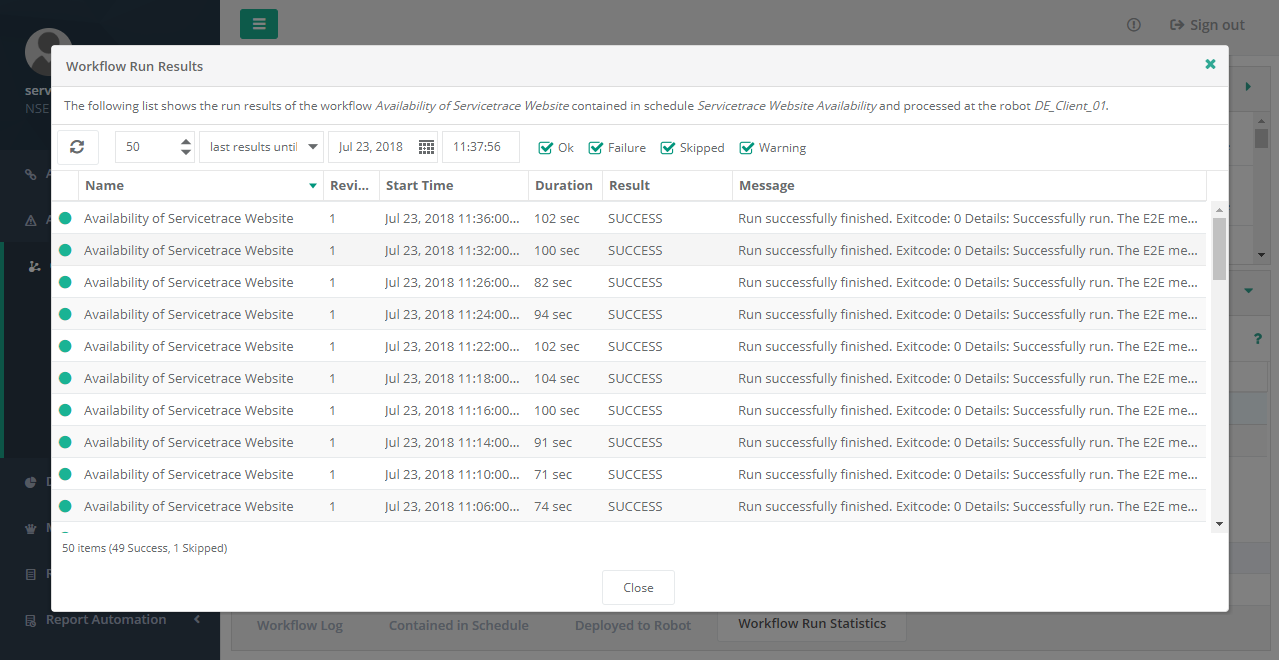
The drill-down supports the retrieval of four different lists of Workflow run results. Please note that the drill-down view is limited to a number smaller than the number of results within the statistics. Thus the drill-down may not contain all results relating to the selected entity.
- The Workflow run results for the last N hours.
Please note: A maximum time span of 72 h may be specified. For performance reasons, the maximum number of results per Workflow is limited to 2,000. This may lead to run statistics starting later than the specified N hours in the past.
- The Workflow run results for the last N hours leading up to the specified date and time. The time has to be
provided in 24 hour format (hh:mm:ss).
Please note: A maximum time span of 72 h may be specified. For performance reasons, statistics are calculated based on a maximum of 2,000 results per Workflow. This may lead to run statistics that finish at the specified date and time, but start later than the specified N hours in the past.
- The last N Workflow run statistics.
Please note: A maximum value N of 2,000 can be specified. The value N applies to each selected Workflow, i.e. statistics are calculated based on N results per Workflow.
- The last N Workflow run statistics leading up to the specified date and time. Time has to be specified in 24 hour
format (hh:mm:ss).
Please note: A maximum value N of 2,000 can be specified. The value N applies to each selected Workflow, i.e. statistics are calculated based on N results per Workflow.
Please note
A Windows registry key can be used to specify how long Workflow run results are stored. Within the Registry key HKEY_LOCAL_MACHINE\SOFTWARE\ServiceTracer\CC,
the value (DWORD) DeleteRunResultsOlderThanDays specifies the number of days Workflow run results remain stored in the database.
All run results older than the specified number of days will be deleted periodically. The default time span for Workflow run results
storage is 90 days.
Workflow Run Results
The Workflow Run Results window provides a summary of Workflow runs during the specified time period. Click on the bold entries in
the table to open the Workflow Run Statistics.
If an Analysis Package exists for the Workflow run, then this can be
downloaded by clicking on the link in the Result column. Analysis Packages are normally only generated if an error occurs
while running the Workflow (EXECUTION_FAILURE). They can also be generated for successful runs by setting the Analysis Package on
OK flag on the Session Monitoring tab in Robot Configuration.
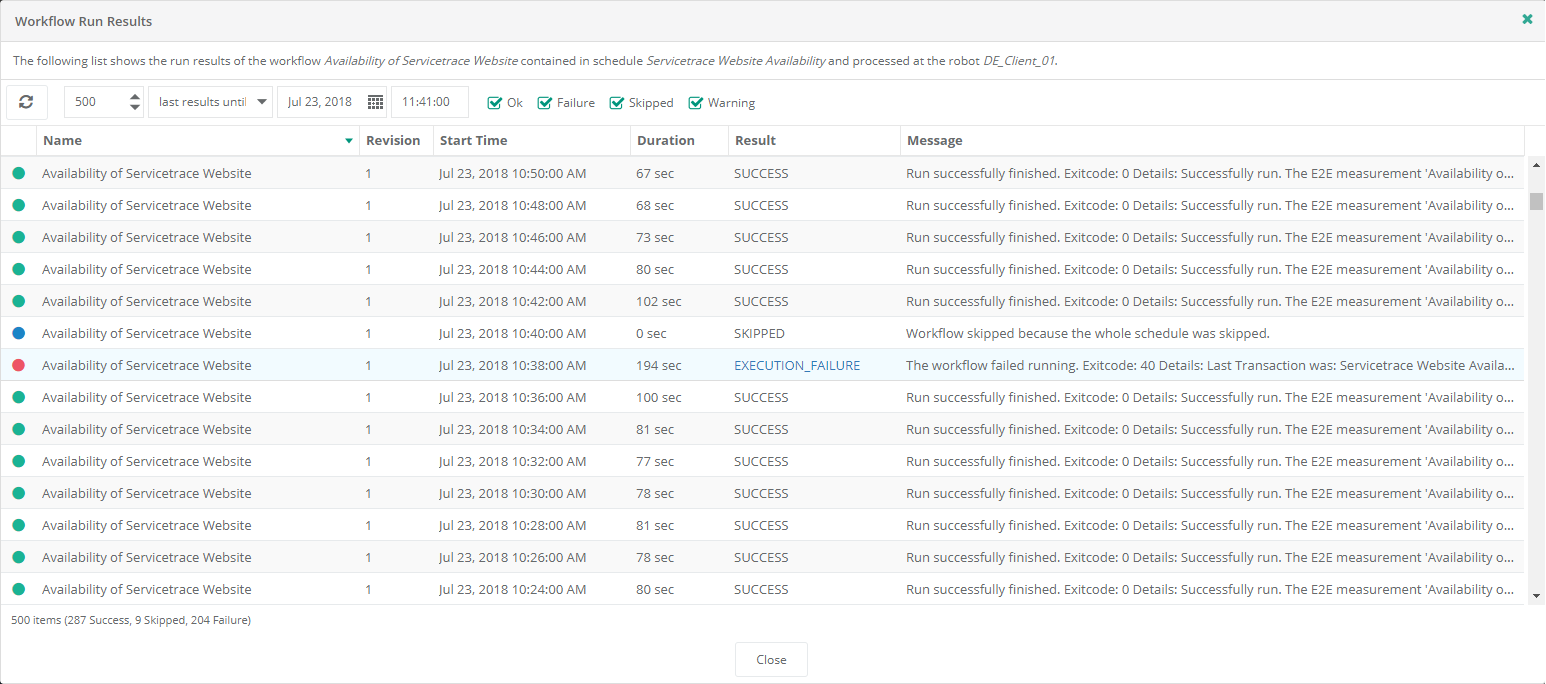
Export Workflow Run Results
An Analysis Package can be downloaded by clicking on the associated link in the table.
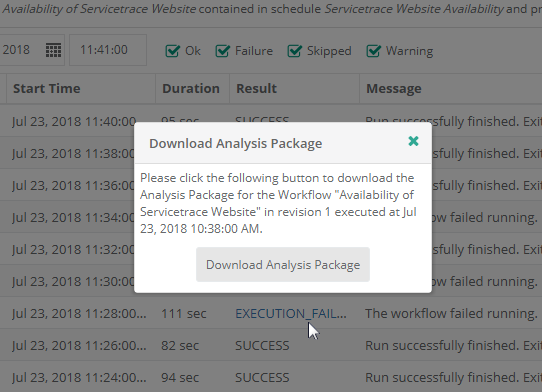
Analysis Packages are provided as compressed ZIP files and, in addition to the log file, also contain screenshots captured at the time the error occurred.
Analysis Packages can also be downloaded via a RESTful interface. The following section describes how to address the interface to export data from the system. For clarity, the value to be substituted for each URL parameter is shown in angle brackets. Do not include these when entering the URL.
First you need the base URL. The structure is as follows:
<protocol>://<domain:port>/ControlCenterServer/WorkflowManagementServiceRESTStream.svc |
Use the protocol, domain, and port corresponding to the associated ServiceTracer host.
Options are provided for exporting either a specific Analysis Package or the most recent one.
Use the following URL to export a specific Analysis Package:
<baseURL>/analysisPackage.zip? |
Further parameters must be provided at the end of the URL in order to specify the data for export more precisely. These parameters must be separated using an & symbol. The required IDs can be found via the web interface. "ID" columns can be displayed in the Workflow and Workflow Run Results tables for this purpose.
Customer=<CustomerId> |
ID of the Customer that the Workflow is associated with. |
WorkflowRunId=<WorkflowRunId> |
ID of the Workflow Run associated with the Analysis Package to be exported. |
loginName=<loginName> |
Name of the user required to log in to the System to export the Analysis Package. This user must be associated with the Customer in question. |
password=<password> |
Password for the user required to log in to the System (in plain text). |
Use the following URL to export the most recent Analysis Package:
<baseURL>/lastAnalysisPackage.zip? |
Further parameters must be provided at the end of the URL in order to specify the data for export more precisely. These parameters must be separated using an & symbol. The required IDs can be found via the web interface. "ID" columns can be displayed in the Workflow and Workflow Run Results tables for this purpose.
Customer=<CustomerId> |
ID of the Customer that the Workflow is associated with. |
workflowId=<workflowId> |
ID of the Workflow for which the Analysis Package relating to the last run is to be exported. |
loginName=<loginName> |
Name of the user required to log in to the System to export the Analysis Package. This user must be associated with the Customer in question. |
password=<password> |
Password for the user required to log in to the System (in plain text). |
See below for an example of a cURL used to export an Analysis Package for a Workflow via a command line program.
curl -o dedicatedAnalysisPackage.zip "http://203.0.113.0/ControlCenterServer/WorkflowManagementServiceRESTStream.svc/analysisPackage.zip?customer=54958217-11C1-4116-B6B9-23BA1E8FD82E&workflowRunId=00a72c0e-0428-4d36-9b34-801cc279cb09&loginName=servicetracer&password=password" |
Graphical Workflow View
The menu item Show Workflow opens a graphical view (tree-like structure) of the Workflow currently selected. Clicking an action step opens its detailed properties in a separate window, which may be split to show either two Workflow revisions or two different Workflows for an easy visual comparison.
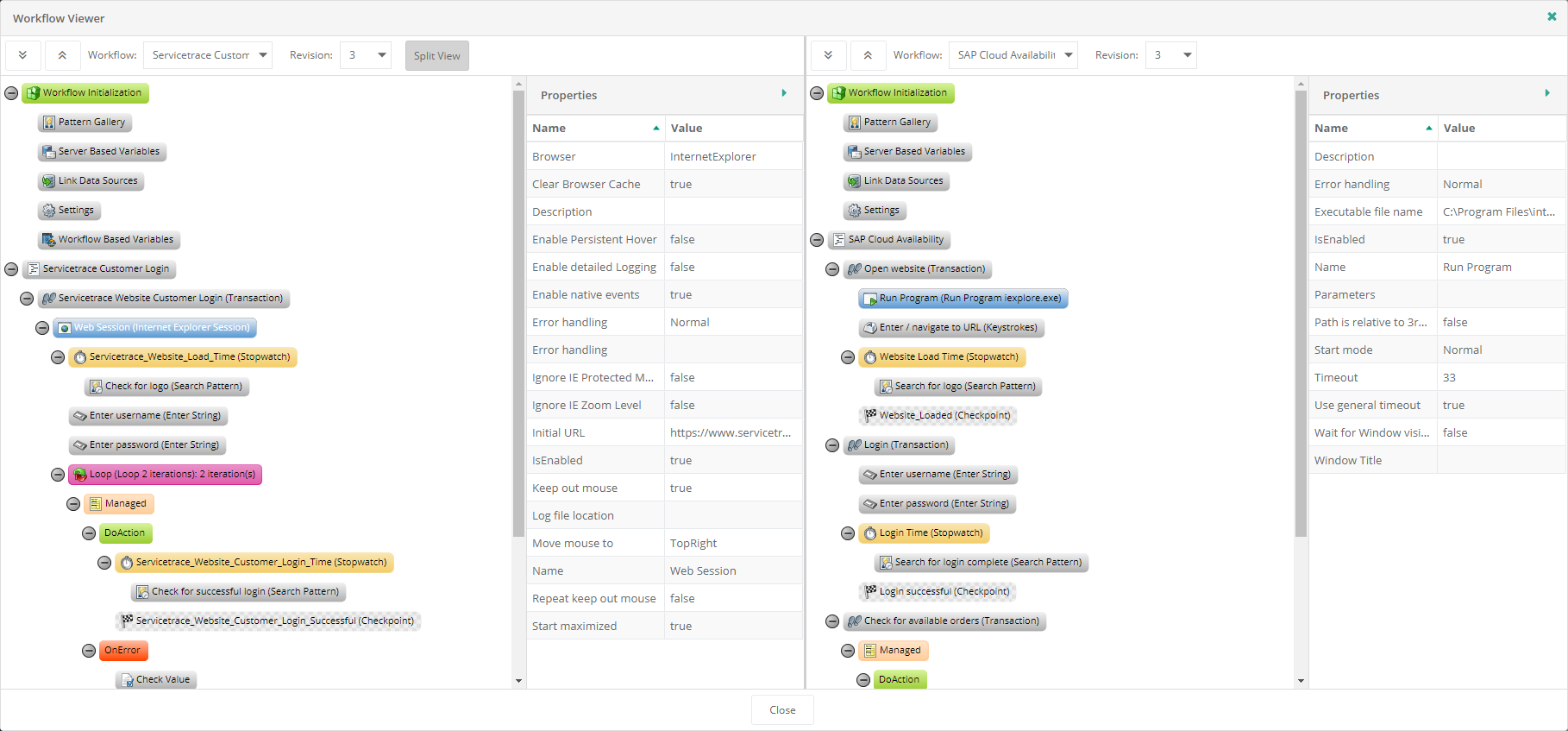
Menu
The Workflow view supports the following menu.
Configuration Table
During the process of creating or modifying a Workflow, users are able to declare Workflow variables of different types. Currently, the following types are supported: Boolean, integer, floating point, string, and simple credentials (login name/password pair). With the aid of the configuration table, users may define these Workflow variables, i.e. specify their values.
The configuration table replaces the auto-configuration assistant specified within a Workflow or Workflow revision.
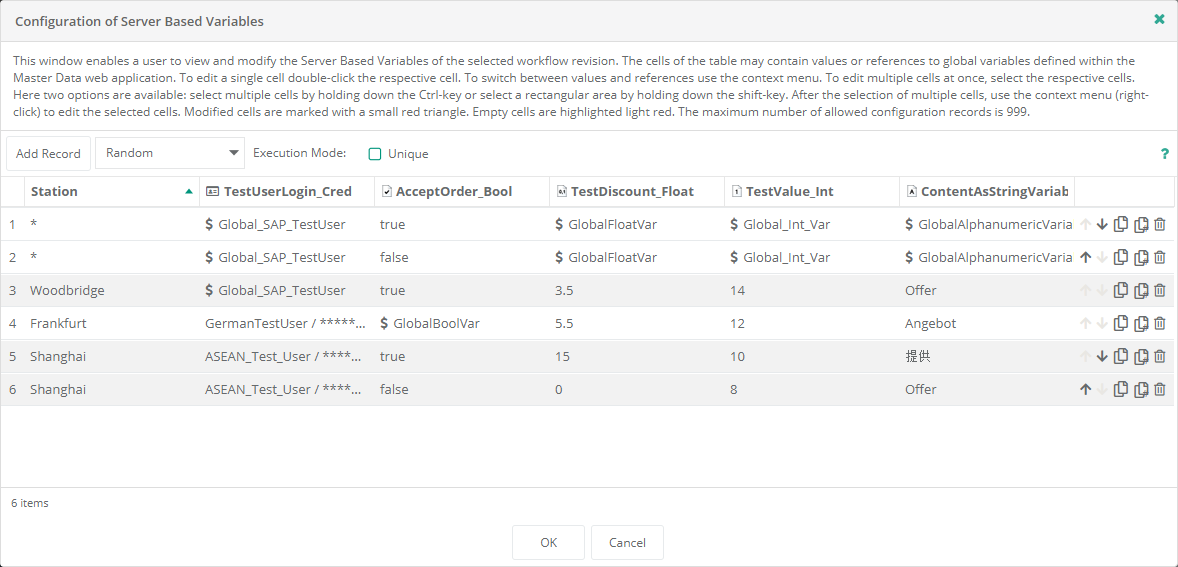
The cells of the configuration table may contain hard-coded values or references to global variables defined within the Master Data web application. The context menu enables users to switch between hard-coded values and references to global variables. A single cell may be edited by double-clicking it, whereas the editing of several cells at once requires initial multiple selection of cells as follows:
- a) Select multiple distinct cells by left-clicking cells while holding down CTRL
- b) Select a rectangular area by left-clicking a cell to define one corner and left-clicking another cell at the opposite corner while holding down SHIFT
After selecting multiple cells, the context menu (right-click within the selection) is used to edit all the selected cells at once.
Columns
The configuration table's columns represent variables of different types, as declared by a Workflow revision. Within a Workflow, these variables are referred to by the special syntax "{$variable}". Declaring a new variable in the Workflow leads to a new column within the configuration table. Please note: It is not possible to declare a new Workflow variable from within the configuration table.
Special Column 'Station'
In addition to Workflow variables, the configuration table contains a special column named Station. This column enables users to define values for Workflow variables on a per-Station basis. The same Station may be included any number of times within the configuration table. Thus the configuration is partitioned by Stations. For the same variable, each (Station) partition may define different values to be retrieved during execution of the Workflow revision at the selected Station. Because a Station virtually denotes a robot, this special column allows users to define different values for different Robots that refer to the same variable.
The Station column may specify a special Station named "*" (asterisk), of which records are used, if the respective Workflow revision is executed at a Station not explicitly specified in the configuration table. Thus records of the * Station define the default values of each Workflow variable. As with standard Stations, Station "*" may be included any number of times within the configuration table.
Right-hand Column
The right-hand column contains the following commands.
 Move Up
Move Up
This menu item is used to move selected records up within the partition of the same Station.
 Move Down
Move Down
This menu item is used to move selected records down within the partition of the same Station.
 Copy
Copy
This menu item is used to copy the selected records.
 Multiple Copy
Multiple Copy
This menu item is used to make a specified number of copies of the record.
 Delete
Delete
This menu item is used to delete the records selected.
Rows
The configuration table's rows represent records, i.e. a set of values to be retrieved during execution of the Workflow revision. The processing of the configuration table and thus the processing of the table's rows (records) supports different processing modes as explained below. As described above, rows are partitioned by Station.
Cells
Each of the configuration table's cells represent a single value of a Workflow variable. Cells may contain two different value types:
- either hard-coded values assigned to the variable's type (e.g. a number, a string, etc.) or
- references to global variables, as specified by web application Master Data.
Note: The second of these value types stores references to global variables, not the values themselves. Therefore, if the value of a global variable is modified within Master Data, then all configuration table records containing a reference to these variables will be modified as well. These modifications will take place during the next Workflow execution.
Modified cells are marked with a small red triangle. Empty cells are highlighted light red.
Processing Mode
A Station (including the special Station "*") may be included any number of times within the configuration table. If a Station is included more than once, then the processing mode governs the processing of all its records. The following processing modes are available:
- Random
Out of all records (rows) specified for a Station (Robot), one is randomly selected during processing of the Workflow revision. - Sequential
The Station (Robot) processes its records (rows) in sequence.
Each processing mode supports the option "Unique", which affects the processing of records associated with the same Station. If activated, it is guaranteed that Workflows of the same revision being executed at the same time will process different records (rows). This is true for different Secure Sessions as well. Thus, at the same time and same Station (Robot), the same record will not be used twice. In other words: a Workflow execution locks the record used during its processing.
Deployed Workflow Revisions
If the configuration table of a Workflow revision already deployed is modified and the default Station "*" is not contained within the configuration table, all Stations that the Workflow revision is deployed to must be specified at least once within the Workflow configuration.
On the other hand, Workflow revisions can only be deployed to Stations as specified in the respective configuration table.
The configuration table may contain Stations that the respective Workflow revision is currently not deployed to.
- The modification of the configuration table does not require the Workflow to be locked by the logged-in user.
- Modification of the configuration table does not generate a new revision of the respective Workflow. Modifications take place the next time the respective Workflow revision is executed.
- Modification of a global variable within the Master Data web application may result in many Workflow revisions already deployed to Robots behaving differently.
Detailed View
Left-clicking a Workflow Name within the Workflow list opens its detailed view, which displays properties depending on the logged-in user type (system/standard) and, if a System User is logged in, depending on the Customer selected by the Customer Switch as well. Workflows that can be selected are highlighted when the mouse is hovered over them.
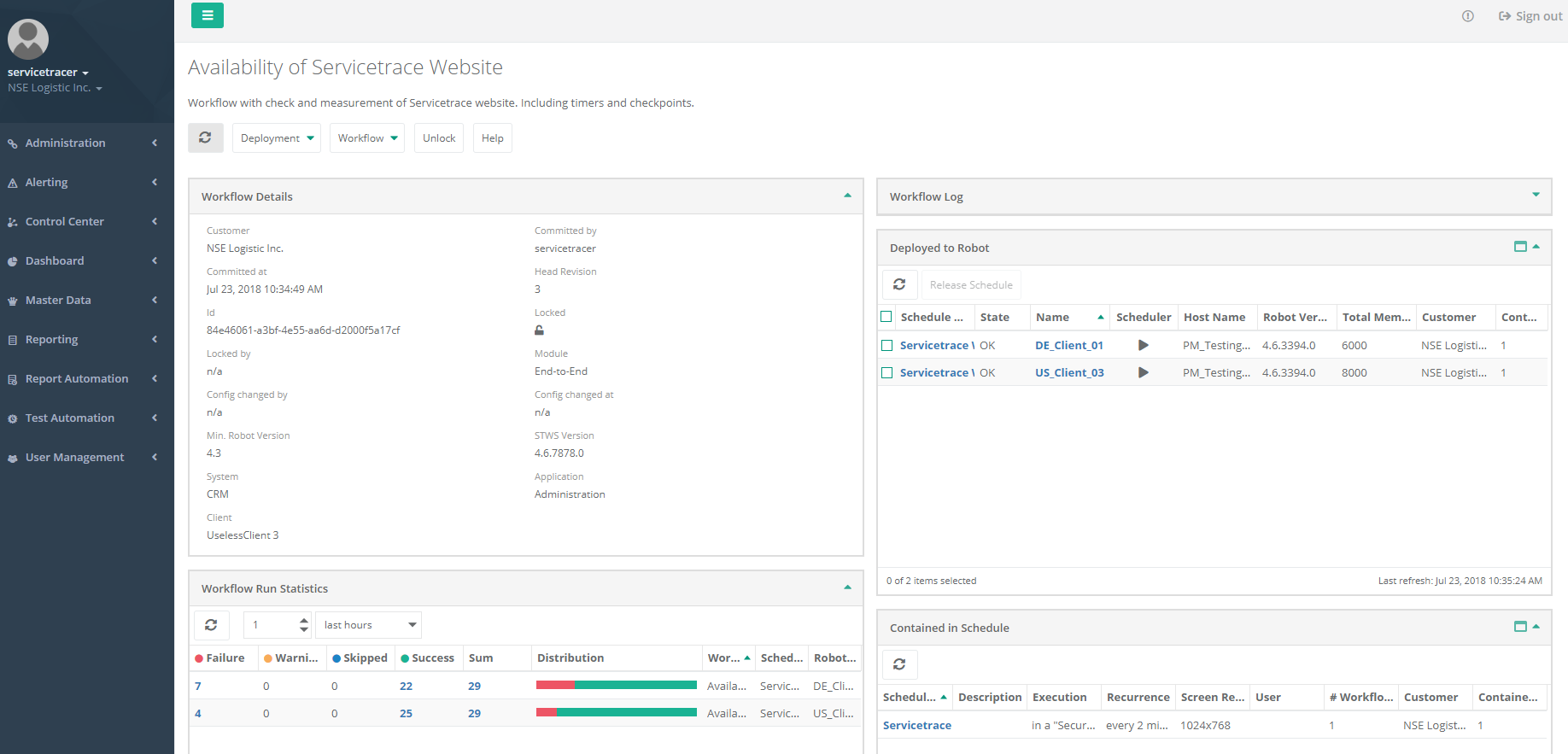
The left pane offers a quick-selection Workflows menu, enabling users to quickly change the Workflow shown within the details view. The list of Workflow names can be reduced/filtered by means of the text field.
In addition to the Workflow's Details (head revision, lock status, etc.), the detailed view contains three additional Workflow-dependent views: Workflow Log showing the Workflow's revision history, Contained in Schedule listing the schedules the Workflow is contained in, and Deployed to Robot listing the Robots the Workflow is deployed to.
The detailed view is implemented as a portal, i.e. the small windows (also called portlets) may be rearranged by drag & drop as required. Clicking the small arrow on the right of the upper section minimizes the portlets.

The logged-in user's type (and, in case of a System User, the currently selected Customer) determine the detailed view's content. This is true for the menu as well. Please see above for a detailed description of each menu item.

 Refresh
Refresh